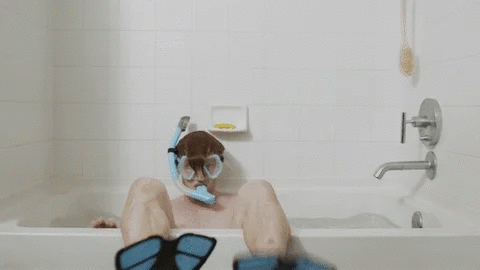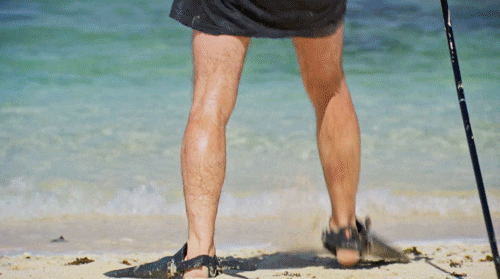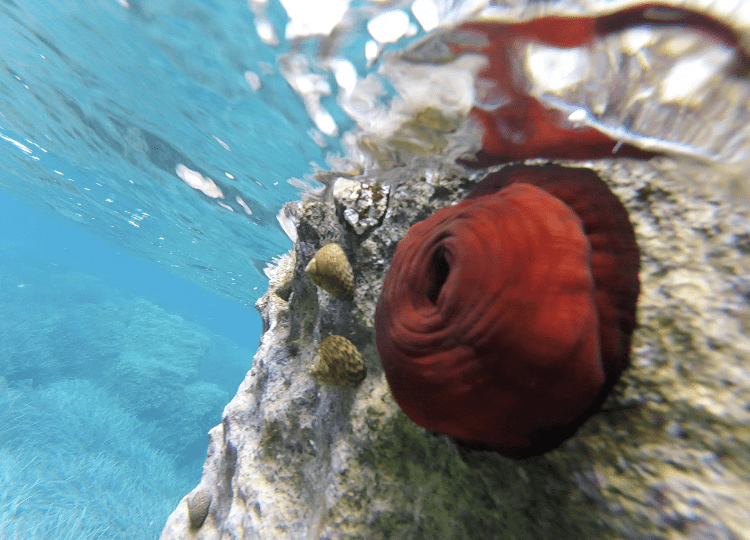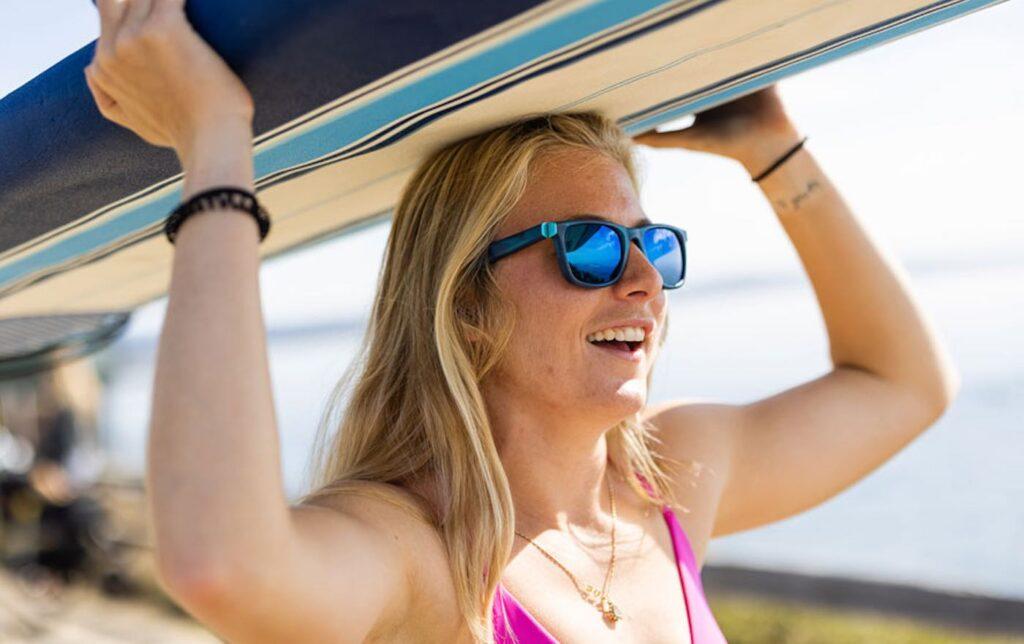30+ Useful Information and Curiosities about Snorkelling
Snorkelling: what it is, how to do it, how to practice it safely
Snorkelling has a very ancient origin, man has always explored the sea from the surface with interest. Here is a short snorkelling guide where you will find useful information for a fun and safe snorkelling trip.
1. What is snorkelling?
Snorkelling is a popular and very exciting water sport that involves watching life underwater with a mask and snorkel while staying on the surface. It is a simple sport and suitable for everyone at all ages.
2. What does snorkelling mean?
Snorkelling means lying face down on the surface of the water using a mask and snorkel to admire the wonders of the underwater environment.
The meaning of the word 'snorkel' can be traced back to the English word 'snorkel' which means snorkel, the tube you use to breathe with your face submerged in the water.
The purpose of snorkelling is not to swim fast but to observe the scenery and fish life.
3. How difficult is it to snorkel?
Snorkelling is very easy and fun. If you are a beginner, you can rely on the experience of a guide who will take you to the best snorkelling spots and give you all the information you need to do this activity safely. It will be a truly enjoyable experience!
4. Why snorkel?
Snorkelling is a relaxing activity that allows you to rediscover and strengthen your contact with nature. This water sport is practised in the water and awakens the 'forgotten sensations' we experienced before birth.
5. What equipment do you need for snorkelling?
The minimum equipment needed for snorkelling consists of a mask, snorkel, fins and warning balloon, and it may also be useful to have a shorty.
- the maskA fundamental component of snorkelling equipment that allows you to see underwater;
- the mouthpieceA rubber or plastic tube used for breathing with the face immersed in water;
- finsThey allow you to move as nimbly through the water as a fish, and fins offer water resistance that allows you to move forward with less effort;
- wetsuitDepending on the latitude and the time of year, you can use a short wetsuit or a long wetsuit to avoid feeling cold;
- the signal balloonfor signalling presence in the water and, if necessary, as a buoyancy aid.
🏆 TIP
The wetsuit is generally not compulsory but it is very useful:
1. to protect against loss of body heat;
2. as buoyancy support;
3. to protect the body in case of accidental shocks.
Even if it's hot, don't snorkel without a wetsuit.
6. Why do you need a mask to see underwater?
Have you ever tried to put your head under water in the bathtub while keeping your eyes open? You can't see very well! So the right question is "Why does it look blurry underwater?“
Underwater you see blurry because our eyes need air to see well, that's how our eyes work!
The purpose of the mask is to provide a small air space between our eyes and what we are looking at underwater; without this space, our eyes cannot focus.
7. How is the mask used?
This is a point of fundamental importance because if the mask is not adequate, there is more fatigue.
Before you start snorkelling it is important:
- Try the maskPlace the mask on your face (without placing the strap on the back of your head) and inhale air through your nose. If the mask remains attached to your face and does not fall off, it means that it adapts well to the shape of your face. This is the right one!
- Adjusting the strapThe strap should be neither too tight nor too loose, if in doubt better loose. It is often thought that it is better to tighten it a lot to prevent water entering the mask, but the tighter you tighten the strap, the more water will enter. If you tighten it too much, moreover, you will be left with a conspicuous mark on your face for a few minutes, tracing the mask.
🏆 TIP
Remember that the tighter you tighten the mask strap, the more water gets in!
- Putting on anti-fog: devi sapere che quando usi la maschera il vetro si appanna quindi non si vede nulla, ecco perchè è necessario fare un trattamento antiappannante. Prima di bagnare la maschera è necessario mettere della saliva sulla parte interna del vetro e spalmarla bene, in gergo si dice 😜 “sputare la maschera”. Questa operazione può sembrare ripugnante ma è davvero molto utile per evitare che la maschera si appanni.
🏆 TIP
VERY IMPORTANT the mask must be dry when performing the anti-fog operation,
There are also anti-mask spays on the market, but nothing works better than saliva.
8. Can I keep my glasses on when snorkelling?
There are no masks that can be worn with eyeglasses, if you have vision problems you can wear contact lenses.
Consider that if your problem is mild (i.e. you don't have severe vision problems), you will most likely not have any difficulty seeing because the water correction factor tends to make things look closer than 25% and bigger than about 30%. This is why fishermen say they have caught huge fish!
🏆 TIP
If you get hooked in the future, you will be able to buy goggles with graduated lenses with the correction factor that suits your needs.
9. Why do you need a snorkel to snorkel?
The snorkel allows you to breathe comfortably while lying on the surface of the water without having to constantly lift your head for air. Snorkelling without a snorkel is very uncomfortable.
10. How do you use a snorkel for snorkelling?
The snorkel for snorkelling should be comfortable and of an appropriate size for the mouth. Children's snorkels are not suitable for adults and vice versa. A snorkel that is too big makes the cheeks cramp, a snorkel that is too small is uncomfortable and lets water in.
After finding an appropriately sized mouthpiece it is necessary to check that the stalks - the little teeth - on the bite of the aerator are intact. These stalks are necessary to position the mouthpiece correctly in the mouth and to prevent water from entering.
Correct use of the snorkel involves gently biting the stalks on the bite - tightening them with the teeth without over-tightening - then clamping the surrounding area with the lips to seal. "Fish mouth"
11. Can you breathe underwater with a snorkel?
Snorkelling is done by swimming face down on the surface with fins, mask and snorkel. The snorkel is used to breathe underwater while remaining on the surface. To go deep underwater you need a regulator and tank, but this activity is different from snorkelling.

12. Why do you need fins for snorkelling?
Fins are used to move like a fish because the resistance they offer to the water allows you to move forward with less effort.
🏆 TIP
When snorkelling you have to take your time to see everything and enjoy the experience. If you go fast you miss out on most of the fun!
13. How do you use fins?
The fins must be the right size, if they are too wide you risk losing them, if they are too narrow they hurt the feet and nails.
To check that the fins are the correct size:
wear ONE fin, check that it is not too tight and place your foot with the fin worn on the ground;
Bring the foot on which you did not wear the flipper forward, as if to take a step.
If the fin does not come out, it is the right size!
The technique with which one generally fins is 'legs to style', i.e. churning with the legs. In order not to strain the back too much, it is preferable to also contract the abdominal muscles. When using 'style' fins while snorkelling try not to bend your knees, it is important to keep your legs straight so that the finning is effective without too much energy wasted.
Another type of finning generally reserved for professionals is 'breaststroke legs', this way of finning is very useful in case of back discomfort but is not suitable for those with knee problems. If you are a neophyte, I suggest you use the 'style legs' technique, it will be easier and more comfortable.
🍀 ECOTIP
In order not to damage the environment and to avoid ruining your equipment, do not place your fins on the bottom and do not move them too quickly when you are close to the rocks. By moving your fins on the bottom you could raise a 'sandstorm' which, besides obscuring everything, could harm the flora and fauna.
🏆 TIP
Don't walk with flippers on your feet, if you have to take a few steps it is better to walk backwards to avoid tripping.

14. Why do you use a wetsuit for snorkelling?
The wetsuit serves to protect from the cold, and from shocks as well as to help you float. Snorkelling is not a speed sport, the movements are not fast so without a wetsuit it is easy to feel cold. Also consider that in water the body cools 20 times faster than in air so a wetsuit is always useful.
15. How is the snorkelling suit used?
The wetsuit must be of a suitable size, if too tight it is uncomfortable, if too loose it allows too much water to circulate and therefore does not heat up.
The wetsuit should be worn just before entering the water because it keeps you very warm. This is very important because, especially on summer days, it helps to avoid excessive sweating, possible dehydration or even heatstroke.
16. Can you wear a life jacket when snorkelling?
Of course, you can wear a life jacket over the wetsuit if you wish. Consider that the wetsuit allows you to float easily so it may not be necessary.
17. Why is the balloon used for snorkelling?
The 'diver marker buoy' is a coloured balloon, usually red or orange, with a red flag with a white crossbar. People in the water must stay within 50 metres of the flag, preferably closer. The flag indicates that boats must stay at least 100 metres away.
Sometimes the balloon can be replaced or supplemented with a flag placed on the support boat.
The signal balloon or buoy is therefore indispensable for signalling the presence of people in the water and is also useful for resting.

18. How is the diver's buoy used?
The buoy is equipped with a floating line that allows the balloon to be dragged while snorkelling. It is important that the buoy is close to the group and that the snorkellers remain in a compact formation.
The balloon is generally carried by the snorkelling guide, so it is also useful for quickly locating the guide in case you want to point out something interesting to see.
19. Do you need reef shoes when snorkelling?
No rock shoes are only for walking and are absolutely not suitable for swimming or snorkelling.
When snorkelling your feet do not rest on the bottom so you use fins, which allow you to move easily through the water.
20. Is it necessary to have personal snorkelling equipment?
It is not necessary to have all personal equipment, it is generally included in the price of the snorkelling excursion. Snorkelling tour centres have equipment of all sizes and models, suitable for beginners. In many cases after trying it out in the water you can also buy it if you wish.
When you have learnt snorkelling you will want to have your own equipment that suits your body and your needs, until then you can rent it and try out all the models available.
🏆 TIP
If you have a personal mask, rinse it with fresh water after each use. If you do not use it for long periods store it in a cool, dry and dark place to preserve the rubber/silicone.
21. How do you empty your mask underwater?
During the snorkelling tour you probably won't need to do this because you will spend most of your time on the surface of the water without snorkelling.
However, it may be useful to know that it is possible to empty the mask underwater by looking upwards and blowing air through the nose. The bubbles that come out allow the water that enters the mask to be eliminated.
22. Do you use snorkelling tanks?
No, snorkelling is a surface water sport involving the use of a mask and snorkel (snorkel) to see the seabed.
There is no need to hold your breath - apnea - and no scuba diving tanks are used.
23. Is snorkelling safe even without knowing how to swim?
In general, it is not necessary to be an expert swimmer or to know all swimming styles to snorkel, also because the equipment - wetsuit and balloon - help with buoyancy. However, it is necessary to be familiar with the water and to know the rudiments of swimming.
24. Does snorkelling make you slim?
Snorkelling is a water sport in which one generally moves slowly. Certainly the movement in the water combined with the caloric expenditure to maintain body temperature is an excellent daily workout.
Regular snorkelling combined with a balanced diet with proper hydration contributes to maintaining an ideal weight. Snorkelling is also a relaxing activity that helps the mind get out of its daily routine and achieve a state of mini-fullness.
25. How high is the water where you snorkel?
Snorkelling is generally done in shallow water, near beaches, islands, shoals, reefs and rocks. There are some special cases where snorkelling is done in deeper water, e.g. spotting pelagic fish, but this case is explicitly mentioned in the activity description.
🏆 TIP
The shallower the water, the easier it is to spot all the small animals that inhabit our wonderful sea.
26. What are the best places to snorkel in Sardinia?
As you will have realised by now: if there is sea, you can snorkel. Everywhere in the sea there is something interesting to see while snorkelling.
There are areas that are considered to be of special environmental importance and therefore particularly interesting for eco-tourism activities including snorkelling.
Below is a list of Protected Natural Areas, Parks and Protected Marine Areas in Sardinia (sources sardegnaambiente.it, parks.it) referring to sea activities, where to snorkel or sea watching activities:
National Parks in Sardinia:
- National Park of theLa Maddalena Archipelago (North Sardinia - Arzachena, Palau, Cannigione);
- National Park of theAsinara (North Sardinia - Sassari, Porto Torres, Stintino);
- Gulf of Orosei and Gennargentu National Park (East Sardinia - Gulf of Orosei, Dorgali, Cala Gonone).
Regional Parks of Sardinia:
- Porto Conte Regional Park (North West Sardinia - Alghero);
- Molentargius Regional Park (South Sardinia - Cagliari).
Protected Marine Areas of Sardinia
- Marine Protected Area Tavolara - Punta Coda Cavallo (North East Sardinia - Olbia);
- Marine Protected Area Capo Caccia - Isola Piana (North West Sardinia - Alghero);
- Capo Carbonara Marine Protected Area (South Sardinia - Cagliari, Villasimius);
- Marine Protected Area Capo Testa - Punta Falcone (North Sardinia - Santa Teresa Gallura);
- Area Marina Protetta Penisola del Sinis - Mal di Ventre Island (West Sardinia - Oristano);
- Sanctuary for Marine Mammals (France Italy, Liguria - Tuscany - Corsica - Sardinia).
Natural Monuments in Sardinia
- Natural Monument Punta Goloritzè (East Sardinia - Baunei, Gulf of Orosei, Dorgali, Cala Gonone).
27. Where is snorkelling best: sand, rock or grasslands?
Everywhere there is something to see, you just have to know how to look.
There are many interesting snorkelling scenarios in the Mediterranean Sea, each with its own peculiarities.
The main underwater scenarios you will visit on a snorkelling excursion:
Snorkelling on the sandAt first glance, this substrate might seem uninteresting as animals living on the sand generally blend in well, but to the attentive eye the sand reveals its explosion of life. Many animals can be found on the sand, including the comb fish, holothuria, owl fish, sole, sand star, mullet, stingray, sand crab and the sand urchin, which is difficult to see because it lives sunken. During night snorkelling excursions it is possible to encounter the Balearic conger-eel, a common encounter at night that is always very impressive.
Snorkelling on rocks and pebblesThis is a really interesting environment to explore where one can admire an incredible variety of species, both animal and plant. Among the rocks, animals find refuge, so by peeping into the crevices you can admire chilli fish, crabs, shells, urchins and starfish. Among the fish you can spot moray eel, grouper, corvina, musdea and the Apogon or King of Mullet living under the rocks. You can also see expanses of sea umbrellas - Acetabularia acetabulum - the single-celled algae visible to the naked eye. You can admire green algae and brown algae by noticing the difference in vegetation between the upper part of the rocks, which is illuminated by the sun, and the part below, which remains in shadow.
🍀 ECOTIP
Try not to touch anything and be especially careful using your fins, with a small movement you could destroy the work that nature has done over thousands of years.
Snorkelling on grasslands: the prairies of Posidonia oceanica are a concentration of life, the leaves, stems and roots of this aquatic plant are a huge nursery where animals find food and shelter from predators. Among the fish that can be spotted are surely the salpa - a vegetarian fish that spends its day grazing in shoals - the bream, the damsel and on luckier days perhaps the needlefish calvallino. On the posidonia leaves you can also find nudibranches, small stars and patiently laid eggs. Remember that in the water you often 'don't see what you don't know', because in the sea there are animals of the most diverse shapes and colours, animals that look like a plant, a flower or a certiolus.
🏆 TIP
STAY CLOSE TO THE GUIDE, an experienced snorkelling guide will point out a spot that at first seems empty but then, as you get closer, the wonders of the sea magically appear.
28. What do benthos, necton and plankton mean?
Benthosare all those aquatic organisms that live in solidarity with the seabed. Examples of benthic animals that spend part or all of their life on the seabed are the sea tomato (fig. 1), the sole, the sea urchin and the starfish.
Nectonare all animals that live and move actively in the water column. Examples of nectonic animals are the seabream (fig. 2), tuna, amberjack and seabream.
PlanktonThese are all organisms, both animal and plant, that live suspended in the water without being able to resist wave motion and currents. Examples of planktonic organisms are the jellyfish (fig.3), the Talya democratica and the Venus girdle, the krill.
The difference between plankton and necton lies in the fact that necton is able to resist waves and currents while plankton is at the mercy of them. On a snorkelling excursion you will certainly see specimens belonging to all 3 categories.
29. Difference between algae and plants?
Aquatic plants have roots, stems, leaves and bear flowers and fruit, just like terrestrial plants.
Algae, on the other hand, are 'thallus' organisms, which means that their bodies are not differentiated into tissues; algae have no leaves, stems or roots and do not make flowers or fruit.
Posidonia oceanica is an essential marine plant for the preservation of coastlines because its roots hold the soil, preventing coastal erosion. Its leaves also shelter many animals that can reproduce and populate the sea.
🍀 ECOTIP
Do not tear up leaves and plants, just as in the mountains plants are very important because they hold the soil with their roots
30. Difference between sole and turbot?
As soon as they are born, these little fish have 'normal' symmetry - one eye on the left, one eye on the right and the mouth in the middle. During development, the fish lie on the bottom and the eye facing the sand migrates to the other, as does the mouth. The result is that as adults turbot and sole live with one side lying on the bottom and have eyes and mouth on the side of the body facing the water. Sole have both eyes and mouth on the right side, turbot on the left side.
31. There are strange animals that look like flowers
In the sea there are many animals with incredible shapes and colours. On land we are used to:
plants that live with their roots embedded in the soil from which they draw nutrients
animals that move, walk, fly, crawl, in short, move to get food.
In water, our idea of animal and plant is somewhat disrupted because in the sea there are many animals that live sedentarily attached to a substrate (rocks, sand). These animals can live their lives without moving because the water, which has a higher density than air, brings food right in front of their mouths. Hence, animals in the sea can take on forms different from those we are used to and even resemble plants, flowers, leaves. Some are so different that 'if you don't know them, you don't see them'.
32. Can I collect sand and shells while snorkelling?
No, it is not allowed to take anything from the sea and in many areas it is forbidden by law.
Consider that if all the people took away shells or sand then there would not be much left to see.
🍀 ECOTIP
Snorkelling is an ecological activity in full contact with nature: 'it only takes away memories and leaves only bubbles'.
How useful was this post?
Click on a star to rate it!
Average rating 4.8 / 5. Vote count: 53
No votes so far! Be the first to rate this post.
















2 responses
Can I book for 7 July? We have never come to Sardinia and are looking forward to it
Of course, select the excursion you prefer and send a private message to the tour organiser.